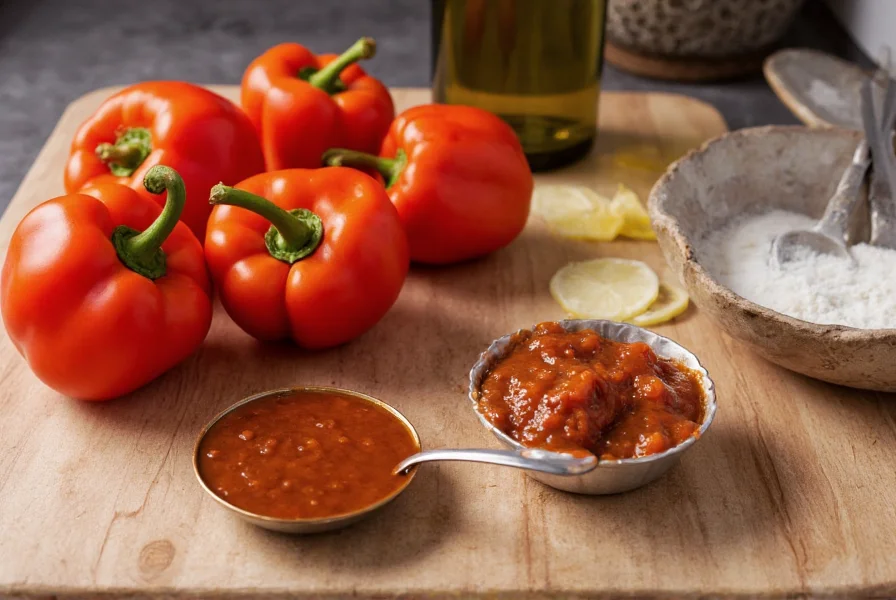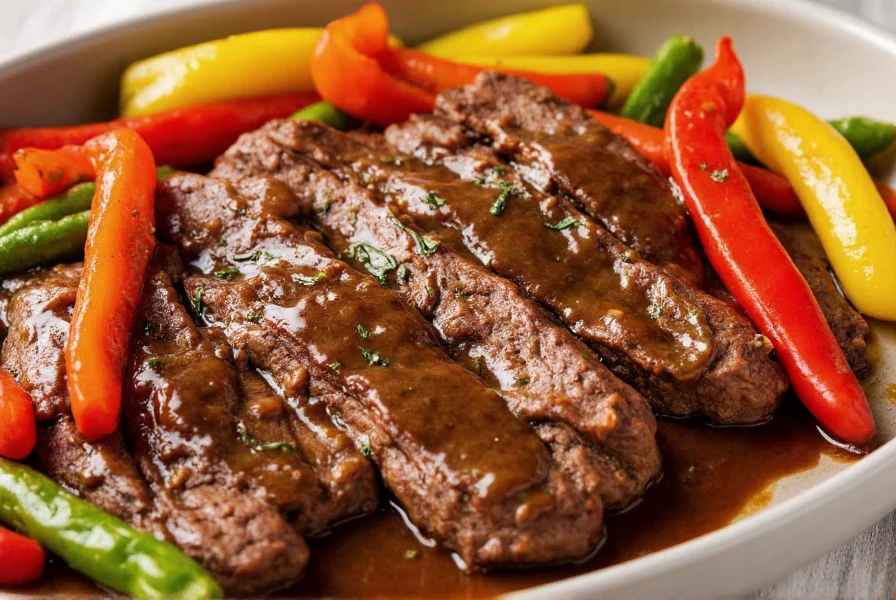The classic pepper steak sauce recipe combines 1/4 cup soy sauce, 2 tablespoons brown sugar, 1 tablespoon cornstarch, 1/4 cup beef broth, 1 tablespoon rice vinegar, 1 teaspoon sesame oil, and 1 minced garlic clove. Simmer for 3-5 minutes until thickened. This authentic stir-fry sauce creates the perfect balance of savory, sweet, and tangy flavors for pepper steak dishes.
Creating the perfect pepper steak sauce requires understanding the delicate balance of flavors that define this classic Chinese-American dish. Unlike store-bought versions, homemade pepper steak sauce offers superior freshness and allows for customization to suit your taste preferences. The foundation of any exceptional pepper steak sauce recipe lies in quality ingredients and proper technique.
Essential Ingredients for Authentic Pepper Steak Sauce
While variations exist, the core ingredients remain consistent for that signature flavor profile. Here's what you'll need for the best pepper steak sauce:
| Ingredient | Measurement | Notes |
|---|---|---|
| Soy sauce | 1/4 cup | Use low-sodium for better control of saltiness |
| Brown sugar | 2 tablespoons | Packed for accurate measurement |
| Cornstarch | 1 tablespoon | Essential for proper thickening |
| Beef broth | 1/4 cup | Homemade yields best flavor |
| Rice vinegar | 1 tablespoon | Adds necessary tanginess |
| Sesame oil | 1 teaspoon | Use toasted for richer flavor |
| Garlic | 1 clove, minced | Fresh is always best |
| Ginger | 1 teaspoon, grated | Adds aromatic complexity |

Step-by-Step Preparation Guide
Follow these steps for the perfect pepper steak sauce every time:
- Prepare the cornstarch slurry: In a small bowl, whisk together cornstarch and 2 tablespoons cold water until smooth. This prevents lumps in your final sauce.
- Combine liquid ingredients: In a saucepan, mix soy sauce, brown sugar, beef broth, rice vinegar, sesame oil, minced garlic, and grated ginger.
- Thicken the sauce: Bring the mixture to a gentle simmer over medium heat, then slowly whisk in the cornstarch slurry.
- Simmer to perfection: Continue cooking for 3-5 minutes, stirring constantly, until the sauce thickens to a glossy consistency that coats the back of a spoon.
- Strain for smoothness (optional): For restaurant-quality smoothness, strain the sauce through a fine mesh sieve to remove any garlic or ginger particles.
- Cool slightly: Remove from heat and let cool for 5 minutes before using with your cooked steak and vegetables.
Pro Tips for Perfect Pepper Steak Sauce
Mastering pepper steak sauce requires attention to detail. These professional techniques will elevate your homemade pepper steak sauce:
- Temperature control: Never boil the sauce after adding cornstarch, as high heat can cause the sauce to break down and become thin again.
- Balancing flavors: Taste and adjust before serving. Need more sweetness? Add a pinch of sugar. Too salty? A splash of rice vinegar helps balance.
- Fresh aromatics: Always use freshly minced garlic and grated ginger rather than powdered versions for superior flavor.
- Sauce consistency: The ideal pepper steak sauce should coat the back of a spoon but still flow slowly when tilted.
- Timing: Prepare the sauce while your steak and vegetables are cooking for perfect timing.
Variations for Different Dietary Needs
Adapt this easy pepper steak sauce recipe to accommodate various dietary requirements without sacrificing flavor:
Gluten-Free Pepper Steak Sauce
Replace regular soy sauce with tamari or a certified gluten-free soy sauce alternative. Ensure your beef broth is also gluten-free. This simple substitution creates a perfect gluten-free pepper steak sauce that maintains all the traditional flavors.
Spicy Pepper Steak Sauce
Add 1-2 teaspoons of sambal oelek or 1/2 teaspoon red pepper flakes during the simmering process. For authentic heat, include a few slices of fresh Thai chili pepper when sautéing your aromatics.
Low-Sodium Version
Use low-sodium beef broth and reduce soy sauce to 3 tablespoons, replacing the difference with additional broth. Add 1/4 teaspoon mushroom powder for umami depth without salt.

Common Mistakes to Avoid
Even experienced cooks make these errors when preparing pepper steak sauce. Avoid these pitfalls for restaurant-quality results at home:
- Adding cornstarch directly: Always make a slurry first to prevent lumps in your pepper steak sauce.
- Overcooking the sauce: Extended boiling after thickening causes the sauce to break down and become thin.
- Using old ingredients: Stale soy sauce or rancid sesame oil dramatically affects flavor quality.
- Not tasting before serving: Sauce flavors change as they cook, so always adjust seasoning at the end.
- Adding sauce to cold ingredients: Toss the sauce with hot steak and vegetables to help it adhere properly.
Serving Suggestions and Pairing Ideas
The perfect pepper steak sauce deserves equally thoughtful presentation. Serve your pepper steak creation over:
- Steamed jasmine rice for classic pairing
- Cauliflower rice for low-carb option
- Noodles for a heartier meal
- Alongside simple stir-fried broccoli
Garnish with toasted sesame seeds and thinly sliced green onions for authentic presentation. For complete meal planning, pair with egg drop soup and steamed dumplings for an authentic Chinese-American dining experience at home.
Storage and Reheating Instructions
Proper storage ensures your homemade pepper steak sauce maintains quality:
- Refrigeration: Store in an airtight container for up to 5 days
- Freezing: Freeze for up to 3 months in portion-sized containers
- Reheating: Gently warm in a saucepan over low heat, adding a splash of broth if too thick
- Reviving: If sauce separates, whisk vigorously while reheating to restore emulsion
Remember that cornstarch-thickened sauces may thin slightly when reheated. If needed, create a small cornstarch slurry and whisk it into the warming sauce to restore proper consistency.
Frequently Asked Questions
Can I make pepper steak sauce without cornstarch?
Yes, you can substitute cornstarch with arrowroot powder (use 2 tablespoons) or create a beurre manié (equal parts softened butter and flour). Arrowroot creates a similar glossy finish but works better with acidic ingredients. For authentic Chinese pepper steak sauce, cornstarch remains the traditional thickener that creates the signature texture.
Why does my pepper steak sauce turn out watery?
A watery pepper steak sauce typically results from insufficient cornstarch, boiling after thickening, or not simmering long enough. Ensure you use the proper cornstarch-to-liquid ratio (1 tablespoon cornstarch to 1 cup liquid), avoid vigorous boiling after adding the slurry, and simmer until the sauce coats the back of a spoon. If your sauce remains thin, create a fresh slurry and whisk it in gradually while heating.
How can I make my pepper steak sauce more flavorful?
Enhance your pepper steak sauce flavor by using homemade beef broth, adding 1/2 teaspoon Chinese five-spice powder, including a splash of Shaoxing wine, or incorporating a small amount of oyster sauce. Sautéing your aromatics (garlic and ginger) in sesame oil before adding other ingredients also builds deeper flavor. For umami richness, add a teaspoon of mushroom powder or a small piece of kombu while simmering.
Can I use this sauce for other dishes besides pepper steak?
Absolutely! This versatile pepper steak sauce works wonderfully as a base for other stir-fries including chicken, shrimp, or tofu dishes. It also makes an excellent dipping sauce for spring rolls or potstickers when slightly thinned with additional broth. Many home cooks use this same sauce recipe for creating homemade Chinese takeout-style dishes like beef with broccoli or Mongolian beef.
What's the difference between pepper steak sauce and other Chinese stir-fry sauces?
Pepper steak sauce features bell peppers as the primary vegetable and has a balanced sweet-savory profile with noticeable black pepper notes. Unlike teriyaki (which is sweeter and uses mirin), or General Tso's sauce (which is spicier and more vinegar-forward), authentic pepper steak sauce emphasizes the natural flavor of the steak with supporting vegetable elements. The sauce should complement rather than overwhelm the beef and pepper ingredients.











 浙公网安备
33010002000092号
浙公网安备
33010002000092号 浙B2-20120091-4
浙B2-20120091-4